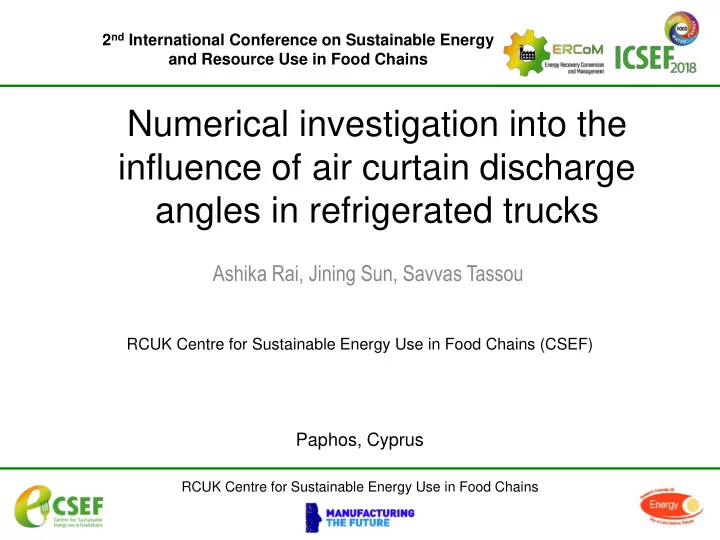

2 nd International Conference on Sustainable Energy and Resource Use in Food Chains Numerical investigation into the influence of air curtain discharge angles in refrigerated trucks Ashika Rai, Jining Sun, Savvas Tassou RCUK Centre for Sustainable Energy Use in Food Chains (CSEF) Paphos, Cyprus RCUK Centre for Sustainable Energy Use in Food Chains
2 nd International Conference on Sustainable Energy and Resource Use in Food Chains Air curtain- effective technology to prevent infiltration Use of diesel powered auxTRUs . • Most-effective protective technology • against infiltration of warm air during door opening. Energy savings of up to 35% . • Majority of air curtain not used in • optimum condition. • How can we further improve the energy efficiency of an air curtain? Infiltration can account for more than half of the overall refrigeration load! Main engine Aux engine RCUK Centre for Sustainable Energy Use in Food Chains 2
2 nd International Conference on Sustainable Energy and Resource Use in Food Chains Influence of discharge jet velocity and angle Adjustment of discharge velocity and discharge angle. • Discharge velocity to improve the strength of air barrier. • Discharge angle to prevent the air leakage losses. • Discharge velocity at 1-5 m/s CFD model RCUK Centre for Sustainable Energy Use in Food Chains 3
2 nd International Conference on Sustainable Energy and Resource Use in Food Chains Recovery energy Set T = 0°C T increase = 15°C Pulldown T = 0°C 𝐹 𝑠 = 𝑁 𝑏𝑗𝑠 𝐷 𝑞𝑏𝑗𝑠 𝑈 𝑏𝑗𝑠 − 𝑈 𝑗𝑜𝑢 + 𝑁 𝑞𝑠𝑝𝑒 𝐷 𝑞𝑞𝑠𝑝𝑒 𝑈 𝑞𝑠𝑝𝑒 − 𝑈 𝑗𝑜𝑗 Energy required to pulldown the temperature of internal air and food products back to set temperature. RCUK Centre for Sustainable Energy Use in Food Chains 4
2 nd International Conference on Sustainable Energy and Resource Use in Food Chains Figure: Recovery energy for angle 0° and 10° At 1 m/s: angles 0° and 10° have similar performance. • 1 m/s to 3 m/s: angle 10° account for less recovery energy in comparison to angle 0°. • 3 m/s to 4 m/s: angle 10° has same recovery energy whereas angle 0° ’ s increases • swiftly. 4 m/s to 4.5 m/s: the recovery energy decreases in 0° case and increases in 10° case. • Beyond 5 m/s: the recovery energy of both the cases, 0° and 10°, increases. • RCUK Centre for Sustainable Energy Use in Food Chains 5
2 nd International Conference on Sustainable Energy and Resource Use in Food Chains Performance at low air curtain velocity 2 m/s 0° 10° Weak discharge jet. • Dominant natural convection. • The effect of discharge angle is very minimal. • RCUK Centre for Sustainable Energy Use in Food Chains 6
2 nd International Conference on Sustainable Energy and Resource Use in Food Chains Performance at mid air curtain velocity 3 m/s 0° 10° In both cases, the discharge jet reaches the floor. • Prevents natural infiltration. • Boundary flow effect and core flow effect. • Bending angle of 10° < bending angle of 0°. • • Two streams at impingement, forced infiltration and outflow. RCUK Centre for Sustainable Energy Use in Food Chains 7
2 nd International Conference on Sustainable Energy and Resource Use in Food Chains Performance at air curtain velocity 4 m/s 0° 10° Air curtain jet velocity much stronger. • • Prevents the deflection created by natural convection thoroughly. Larger share of discharge jet comes in contact with the • floor, ‘attachment angle ’ . Smaller attachment angle = higher forced infiltration. • RCUK Centre for Sustainable Energy Use in Food Chains 8
2 nd International Conference on Sustainable Energy and Resource Use in Food Chains Performance at air curtain velocity 5 m/s 0° 10° Strong forced infiltration. • For 10° case, discharge jet flow outwards, small • impingement. Forced infiltration in 0°<10°. • Higher discharge velocity, lower boundary flow effect. • RCUK Centre for Sustainable Energy Use in Food Chains 9
2 nd International Conference on Sustainable Energy and Resource Use in Food Chains Conclusion Adjusting angle decreases core • flow and boundary flow effect. At low discharge velocity, the jet is • weak and so would be the effect of discharge angle. At velocity explicitly, the bending • effect is high and so would be the effect of discharge jet, energy Energy savings savings of 17.6%. of 35% • At high discharge velocity, not as much jet deflection, energy savings of 5.6%. +17.6% RCUK Centre for Sustainable Energy Use in Food Chains 10
Recommend
More recommend